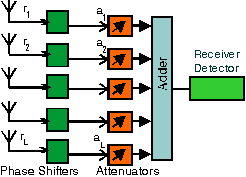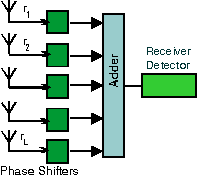
 |
JPL's Wireless Communication Reference WebsiteChapter:
Analog and Digital Transmission
|

Figure: L-branch antenna diversity receiver (L = 5). With EGC, the attenuation/amplification factor a_i is the same for all channels i.
Thus, EGC is simpler to implement than Maximum Ratio Combining (MRC). The adaptively controller amplifiers / attenuators are not needed. Moreover, no channel amplitude estimation is needed.

Figure: L-branch Equal Gain Combining antenna diversity receiver (L = 5).
The average SNR improvement of EGC is typically about 1 dB worse than with MRC, but still much better than without diversity.